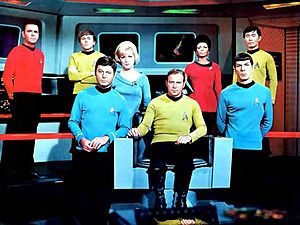
Promotional photo of the cast of Star Trek during the third season (1968–1969). From left to right: James Doohan, Walter Koenig, DeForest Kelley, Majel Barrett, William Shatner, Nichelle Nichols, Leonard Nimoy, and George Takei. (Photo credit: Wikipedia)
This is an excerpt of a version of a paper I wrote for a physics class.
Who knew we’d ever be thanking the laws of probability or our respective intelligent designer of choice for William Shatner? Let’s face facts though- Star Trek: The Original Series would be nothing without that handsome Canadian with a halting way with words. In fact, the pilot episode starred a brooding, stuffy Captain Pike, and the episode was rejected. Since the television series first aired in 1966 with Shatner as Captain Kirk, geeks the world over flocked to their television sets sporting cheap versions of the crew’s uniforms. Unless you were the least popular of your group of friends, meaning you would be forced to wear the cursed red shirt. These skinny, acne scarred types with zero athletic ability evolved through their years to survive by hiding in their bedrooms with their textbooks. The nerds of the Star Trek years became the scientists of today, and they had a cornucopia of inspiration. Books, television shows, and films have all contributed to technology development by offering possibilities as a challenge.
I begin with Star Trek because it has inspired or predicted numerous technological advancements. Video conferencing, personal computers, and phasers (as stun guns) all eventually became reality. Three devices used on the show, however, have directly influenced real life technology. The pilot episode, “The Cage” (1964) gave humanity its first look at mobile communication. A device aptly named The Communicator was used to hold conversations from planet to ship, or from ship to ship. The device featured a flip open cover and that iconic, futuristic ring tone. In 1973, Martin Cooper invented the mobile telephone, and he has openly stated that the idea came straight from the show (1). Bluetooth was first made available in 1994, but it was not the first time that a wireless earpiece was seen by the public. The first aired episode of the first season, “The Man Trap” (1966), was also the first episode to introduce Lieutenant Uhura, the Chief Communications Officer on the Enterprise. She is shown with a small bit of sound transmitting metal dangling from her left ear: a modified version of the Bluetooth earpiece we see these days on busy businessmen.
If you’re familiar with the show, you’ve seen Mr. Spock carrying a rectangular box used for geographic, meteorological, and biological scanning, data collection, and analysis. This device, a tricorder, determines if the oxygen levels in a planet’s atmosphere, warns the crew of an oncoming storm, measures vitals, and much more, all with a simple wave of the device. Currently, all ‘tricorders’ being developed perform only a fraction of the Star Trek version’s tasks. Harvard Medical School has produced a noninvasive, handheld device that uses nuclear magnetic resonance imaging (this is just the familiar MRI, the ‘nuclear’ is dropped because of the general public’s fear of the word) to detect and identify bacteria at 800 times the efficiency of current full sized laboratory equipment (2). Dr. Peter Jansen created The Tricorder Project, a running, open design idea, with which he has built two working Tricorder designs, and has two more on the way. The Tricorder Mark 1 has 11 different sensors, whose purposes are distributed among atmospheric, electromagnetic, and spatial measurements (3). The Mark 2 is similar, but sacrifices one sensor type for upgraded resolution.
References
1. “Is the Star Trek Communicator a SmartPhone.” HubPages. .
2. “Top 10 ‘Star Trek’ Technologies That Actually Came True.” HowStuffWorks. .
3. “The Tricorder Project.” The Tricorder Project. .
Related articles





